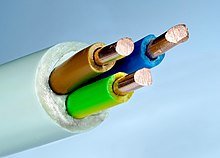Beyond Elementary Physics #1_ The Effect Of Frequency On The Conductivity Of A Dielectric
An elementary Physics student would profess without any atom of doubt that copper, Silver, aluminium and some other metals are pure conductors of electricity at all conditions and would tend to see as inferior anyone who antagonizes his knowledge. Growing up as a science student, I conformed to the elementary Physics idea that copper and aluminium are pure conductors of electricity in all conditions. However, with advancement in the knowledge of Electrical engineering, I discovered through studies that no element on earth is a conductor at all conditions. So, the idea of dielectric replaced conductors. In transmission line, all materials are called dielectrics. Though terms like conductivity, dielectric constant and impedance could be use to describe a dielectric. A material that behaves like conductor might behave as a resistor with change in frequency; for this fact, all materials are called dielectric while operating with alternating current or voltage

Source: Wikipedia under Creative Commons
Conduction of electricity occurs at the surface of dielectrics, that is, voltage or current flows majorly at the skin(surface) of dielectrics. This is the reason why some manufacturers would coat or galvanize some metals with copper and push it to the market for sale.
Skin Effect And Skin Depth
Current flows majorly at the surface of a dielectric an attenuates as it gets to the axis or center of the dielectric. Skin effect is the probability of an alternating current to distribute itself in such a way that current density is more at the surface of a dielectric and reduces with depth. This depth into which current can flow is the effective skin depth of a dielectric. So, in operation with alternating currents, current flows from the surface of the dielectric to a certain depth called skin depth.The skin depth of a dielectric is affected by frequency of the alternating current, the relationship between skin depth and frequency is as below:

Image credit: @ikchris
where
ω= angular frequency= 2πF
ρ = resistivity of the material
µ= µo µr
µo= the permeability of free space
µr = relative magnetic permeability of the conductor
ε= εoεr
εo= the permittivity of free space
εr= relative permittivity of the material
The resistivity and permeability of a material is constant. So, the only variables are the frequency and permittivity. From the mathematical expression above, as the frequency increases, the skin depth decreases; lower skin depth implies higher resistance of a dielectric, as alternating current can only cluster at a small portion of the surface of the dielectric and cannot flow even to the axis of the dielectric.
The resistivity and permeability of copper are 1.72 x 10-8 Ωm, 1.256629×10-6H/m. So, at 60Hz , the skin depth of cooper is around 8.5mm. But, what happens when the frequency of current is in GHz just as in radio stations and some electronic devices? The skin depth decreases of course
A lower skin depth makes the thickness of the dielectric a waste of material, this is the reason a hollow dielectric is used most frequently in radio broadcasting stations operating in frequency of GHz
Finally, at a very high frequency, copper ceases to be a good conductor at it uses to be in lower frequency or operation with DC.
Conclusion
The frequency of alternating current affects immensely the conductivity of a dielectric. Some materials which are good conductors at low frequency might be a bad conductor at higher frequencies due to skin depth. Anyway, there is a way to mitigate increased resistance due to skin effect which would be a publish of another day.Anticipate!!!!!
Nice work.
Love the way you laid those formulas out.
And Yes, there are certain conditions that make some materials not to conduct
(majorly temperature)
Nice post
Am glad you love this @lawkay
Have been following your blog posts for some months now, I observed you are a fan of electrical/electronics Engineering
Now I know the reason my Yagi array tv antenna is made up of hollow aluminium.
Yea thats it.
Thanks for coming around.
Correct one. actually, am just getting to know that the dipper or thicker a conductor the less its conductivity. I think the term dielectric is more suitable for conductors then since the term depends on condition.
Knowledge will never cease. Thanks @ikchris
Thanks for coming around @steepup
When frequency is so high, the thickness of a dielectric becomes a waste of material
Hi @ikchris!
Your post was upvoted by utopian.io in cooperation with steemstem - supporting knowledge, innovation and technological advancement on the Steem Blockchain.
Contribute to Open Source with utopian.io
Learn how to contribute on our website and join the new open source economy.
Want to chat? Join the Utopian Community on Discord https://discord.gg/h52nFrV
This post has been voted on by the steemstem curation team and voting trail.
There is more to SteemSTEM than just writing posts, check here for some more tips on being a community member. You can also join our discord here to get to know the rest of the community!